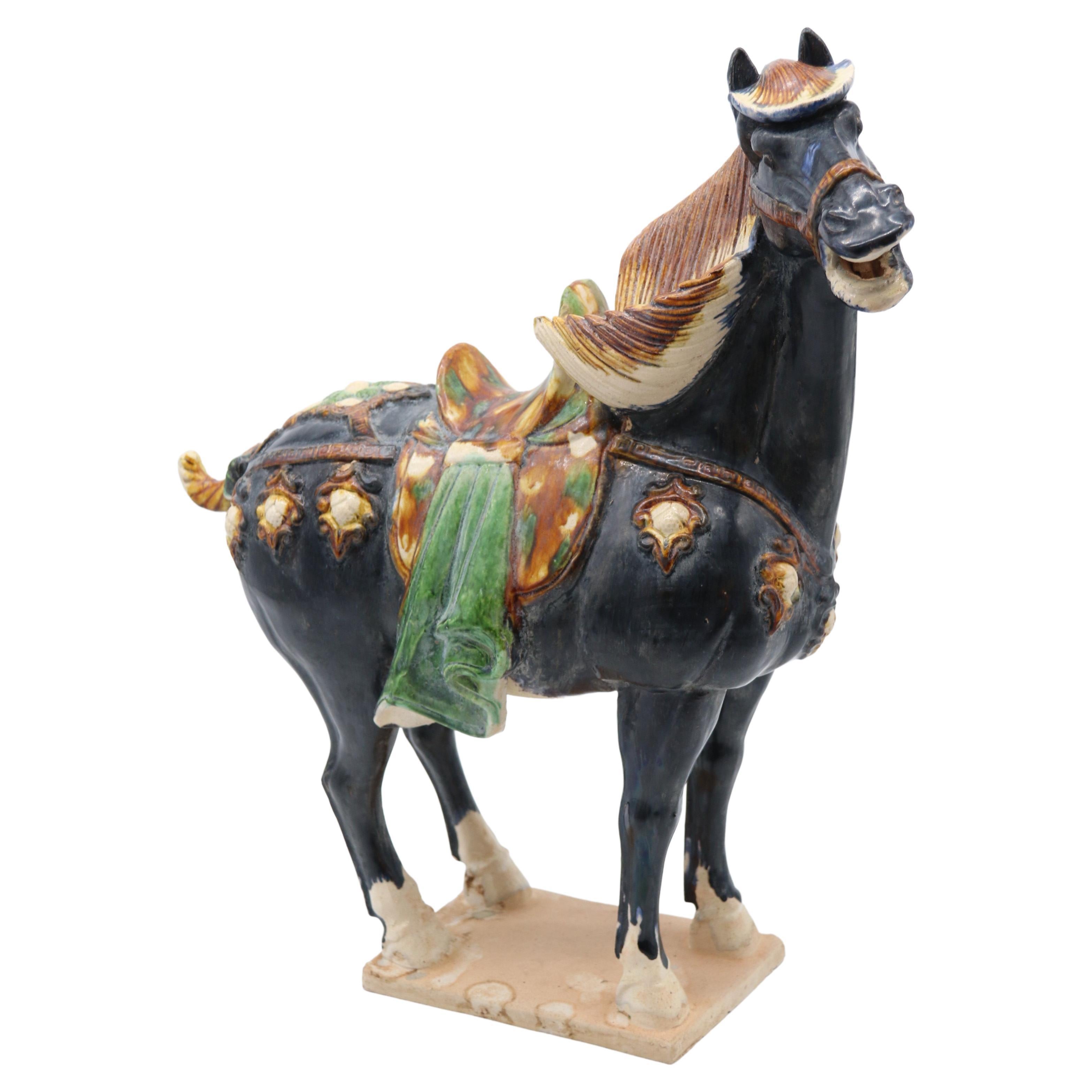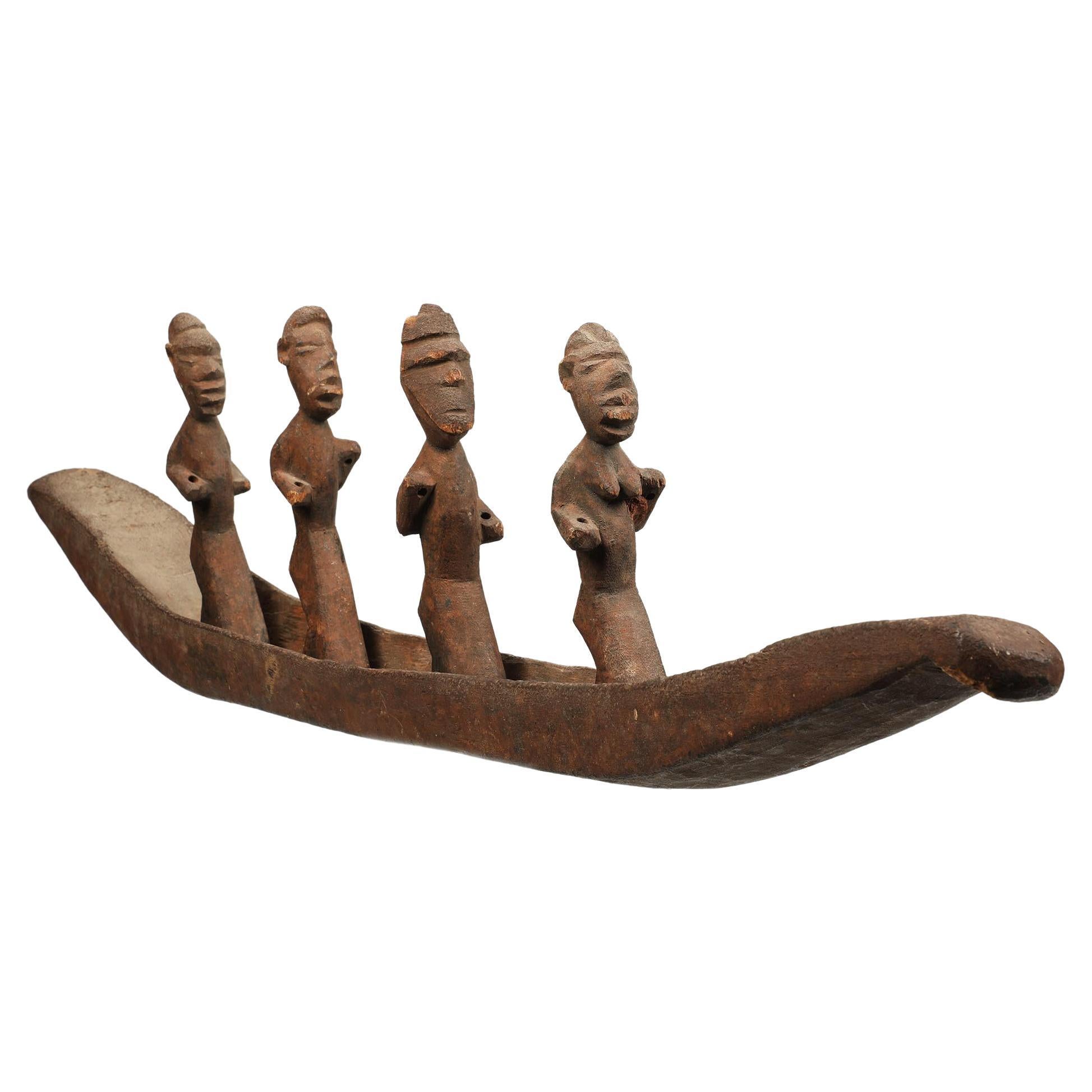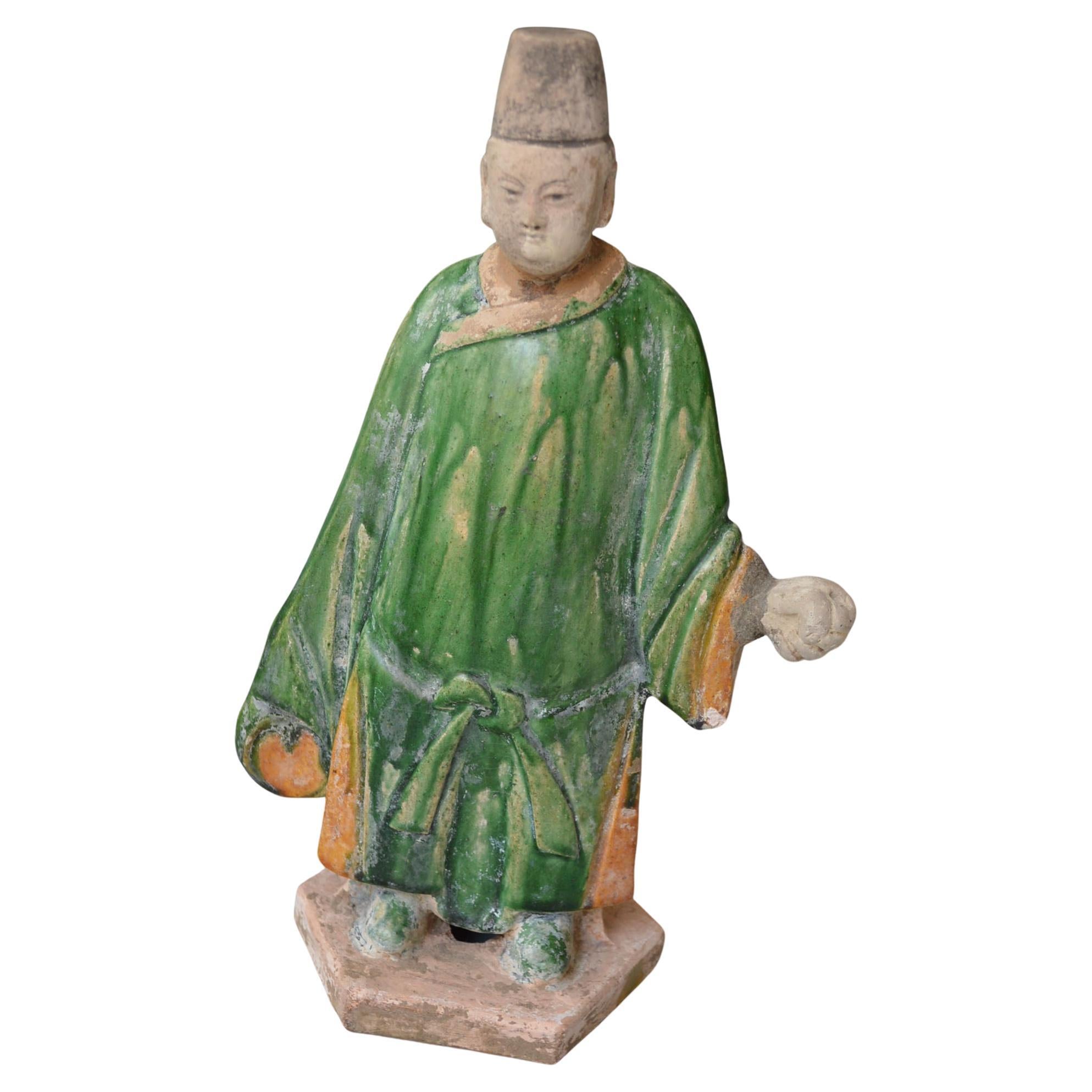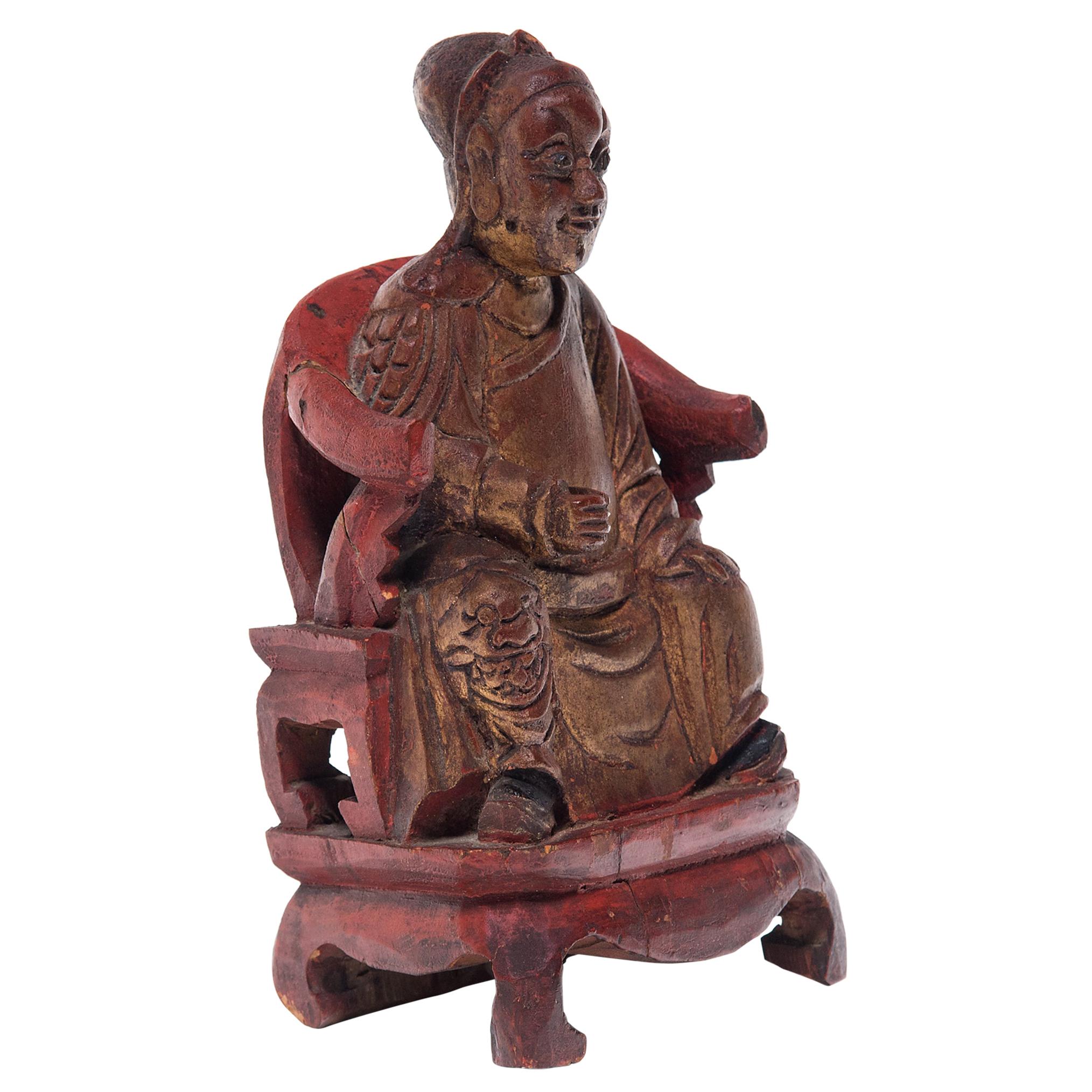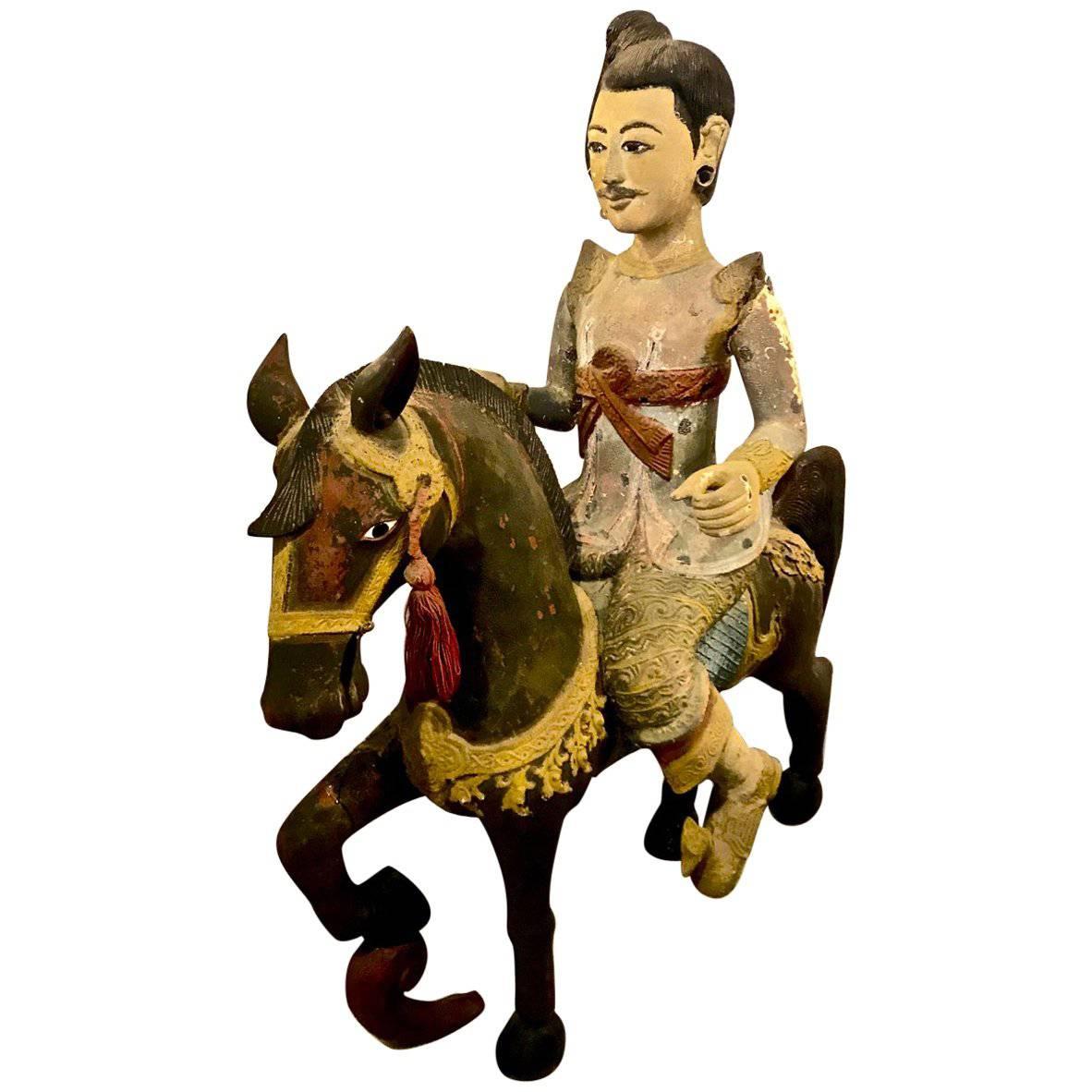Items Similar to Chinese Ming Dynasty Antique Sancai Glazed Attendants Tomb Figure Pair
Want more images or videos?
Request additional images or videos from the seller
1 of 12
Chinese Ming Dynasty Antique Sancai Glazed Attendants Tomb Figure Pair
About the Item
A pair of large antique Chinese polychrome ceramic attendants, Ming Dynasty (1368-1644).
Outstanding 500+ year old Sancai glazed earthenware pottery tomb figures, exceptionally executed figural form, exquisitely detailed, one holding a teapot, the other holding a charger, rising on rare sculptural plinth base with concave side details.
Dimensions: (approx)
13.25" Tall, 5" Wide, 4.5" Deep (each)
Condition Report:
Superb museum quality examples, in excellent original unrestored antique condition. Present well. Desirable crazing to glaze. Rubbing to polychrome details on heads of both, surface wear on both commensurate with age, handling, and exposure.
About Ming Tomb figures:
Tomb figures, also known as mingqi, were funerary objects placed in tombs during the Ming Dynasty (1368-1644) in China. These figures were made of clay, wood, or bronze, and were intended to provide the deceased with companionship, entertainment, and protection in the afterlife. They included statues of people, animals, and mythical creatures, as well as models of houses, furniture, and other objects. These figures were typically painted or glazed, and were often buried with the deceased in their tombs. The production of mingqi was a significant industry during the Ming Dynasty, and many skilled artisans were employed to create these objects.
The number of tomb figures, or mingqi, placed in a Ming Dynasty (1368-1644) tomb varied depending on the wealth and status of the individual being buried. Elite tombs, such as those of emperors and high-ranking officials, could have hundreds or even thousands of mingqi, while the tombs of commoners might have only a few.
The quantity of mingqi sculpture in a tomb also varied depending on the time period and location. For example, tombs from the early Ming period (1368-1425) were typically larger and contained more mingqi than those from the late Ming period (1550-1644) which were smaller. Additionally, tombs from the southern regions of China tended to have more mingqi than those from the north.
In general, it is believed that the purpose of the mingqi was not only to provide the deceased with companionship, entertainment, and protection in the afterlife, but also to demonstrate the wealth and status of the individual during their lifetime.
The size of Ming Dynasty tomb figures, or mingqi, varied depending on the type of object and the wealth and status of the individual for whom it was made. Some of the largest mingqi were statues of people and animals, which were typically several feet tall.
For example, the largest known Ming tomb figure is a clay statue of a horse, which is over 3 meters tall and 4 meters long, and was discovered in the tomb of the Yongle Emperor, who ruled from 1403 to 1424. Other large mingqi include statues of warriors, officials, and guardians, which are typically several feet tall. Additionally, there are large pottery figures of military units, musicians, and even a complete kitchen with all the utensils, which were also intended to serve the deceased in the afterlife.
It's worth noting that many of these large figures have been discovered in tombs of emperors and high-ranking officials, indicating that they were commissioned by those who could afford it and were intended to demonstrate their wealth and status even in the afterlife.
- Dimensions:Height: 13.25 in (33.66 cm)Width: 5 in (12.7 cm)Depth: 4.5 in (11.43 cm)
- Sold As:Set of 2
- Style:Ming (Of the Period)
- Materials and Techniques:
- Place of Origin:
- Period:
- Date of Manufacture:circa 1400s/1500s
- Condition:Wear consistent with age and use. Superb museum quality examples, in excellent original unrestored antique condition. Present well. Desirable crazing to glaze. Rubbing to polychrome details on heads of both, surface wear on both commensurate with age, handling, and exposure.
- Seller Location:Forney, TX
- Reference Number:1stDibs: LU5977236246462
About the Seller
4.8
Platinum Seller
These expertly vetted sellers are 1stDibs' most experienced sellers and are rated highest by our customers.
Established in 2013
1stDibs seller since 2021
200 sales on 1stDibs
Typical response time: <1 hour
- ShippingRetrieving quote...Ships From: Forney, TX
- Return PolicyA return for this item may be initiated within 7 days of delivery.
More From This SellerView All
- Qing Dynasty Chinese Sancai Temple Guardian FigureLocated in Forney, TXA large antique Chinese glazed Sancai pottery temple guardian figure, designed to ward off evil spirits and protect the owners tumb. Hand crafted, excep...Category
Antique 18th Century Sculptures and Carvings
MaterialsPottery
- Pair of Antique Qing Dynasty Chinese Sancai Roof TilesLocated in Forney, TXA pair of Qing dynasty (1636–1912) Sancai glazed ceramic figural roof tiles with rich beautifully aged patina! Dating to the 19th century, wonderfully hand-crafted and painted, sculptural form depicting stylized fish, rising on terracotta clay arched imbrex barrel roof tile. Dimensions: (approx) Each; 13" High, 4.5" Wide, 9" Deep; 8.6lbs total Condition: Great original antique condition with heavy patina over the whole. Significant crazing - craquelure throughout that can only be acquired over long periods of time. Wear consistent with age. We have not cleaned them, leaving them as original, and retaining as much antique character as possible. If you would like them cleaned and polished please let us know after ordering them. History: The Fish, ? (yú) figure is believed to be a symbol of good fortune and longevity. The Fish is one of the several natural or mythical creatures such as Foo Dogs - Guardian Lions that adorn roof edges of Chinese religious temples, official buildings and important structures. Brightly hand painted and glazed ceramic roof tiles...Category
Antique 19th Century Asian Qing Ceramics
MaterialsCeramic, Clay, Paint
- Antique Indian Hand Painted Brass Figural Gauri Head Sculpture PairLocated in Forney, TXA pair of antique Indian hand-painted figural brass head religious sculptures. Hand-crafted in the Maharashtra or Karnataka region of India in the late 19th / early 20th century, d...Category
Antique Late 19th Century Indian Anglo Raj Sculptures and Carvings
MaterialsBrass
- Chinese Ming Dynasty Architectural Terracotta Roof Tile Figure Qilin Foo Dog prLocated in Forney, TXA remarkable pair of large Ming Dynasty (1368-1644) earthenware Imperial roof decorations - ornamental architectural terracotta roof tile beasts. 15th/16th century or earlier, North...Category
Antique 16th Century Chinese Ming Sculptures and Carvings
MaterialsEarthenware, Terracotta
- Baroque Period European Antique Carved Polychrome Santo Altar FigureLocated in Forney, TXA scarce Baroque Period European antique hand carved and painted wood santo altar figure, 17th/18th century, the religious folk art sculpture depicting Ma...Category
Antique 18th Century European Baroque Sculptures and Carvings
MaterialsGesso, Wood, Paint
- Pair of Antique Chinese Glazed Figural CensersLocated in Forney, TXA pair of antique Cizhou-type cream glazed cat (mao) incense stick holders. Dating to the early Qing - possibly late Ming Dynasty, scarce near...Category
Antique 18th Century Chinese Ceramics
MaterialsPorcelain
You May Also Like
- Large Chinese Tang Dynasty Style Sancai Glazed Pottery Horse, circa 1930Located in Central England, GBTrue in all its elements to the original examples which date from the early Chinese Tang period. The black glazed horse is naturalistically modelled. It stands on a rectangular base ...Category
Mid-20th Century Chinese Tang Animal Sculptures
MaterialsPottery
- Salampasu Ritual Wood Boat with Four Masked Figure & Attendants CongoLocated in Point Richmond, CAA very rare assemblage carved wood sculpture of a boat with a row of standing figures, the second wears the classic mask of the Salampasu people, of the Democratic Republic of Congo. Figures are attached with pins to the bottom of the boat...Category
Early 20th Century Congolese Tribal Tribal Art
MaterialsWood
- Chinese Antique Ming Dynasty Glazed Pottery Figure circa 16th Century ADLocated in London, GBChinese Antique Ming Dynasty glazed pottery figure Ming Dynasty circa (14-16 century AD) China, The earthenware with green and yellow glaze Meas...Category
Antique 16th Century Chinese Ceramics
MaterialsPottery
- 18th Century English Wood Carved Standing Chinese Attendant with Lotus BowlLocated in West Palm Beach, FL18th century English wood carved standing Chinese attendant with lotus bowl, The well carved and decorated figure with glass eyes, holding a 10 inch...Category
Antique Late 18th Century English Chinoiserie Figurative Sculptures
MaterialsGesso, Glass, Wood, Paint
- Chinese Gilt Ancestor Figure, c. 1900Located in Chicago, ILAn integral part of traditional Chinese home life, ancestor worship before a domestic altar often featured painted ancestral portraits or tabletop ancestor figure...Category
Early 20th Century Chinese Qing Sculptures and Carvings
MaterialsWood, Lacquer
- Indo-Chinese Burmese Figural Sculpture, Late CenturyLocated in Pasadena, CAThis is an unusually large Burmese mounted Royal Figure or Nat that dates to the late 19th century or early 20th century. The figural group retains all of its original carved element...Category
Antique Late 19th Century Indian Folk Art Sculptures and Carvings
MaterialsPaint, Teak
Recently Viewed
View AllMore Ways To Browse
Ming Tomb
Ceramic Horse Statue
Ming House
Sebastian Herkner Cushion
Bench With Castors
Mini Drink Table
Togo Sofa Two Seater
Art Deco Gondola
Cesare Lacca Cocktail Brass
Magic Glo
Antique Lift Top Bench
Chandigarh 22a
Citrus Fruit
Grapes Pendant Murano
Morrocan Chief
Regency Faux Bamboo Painted Chairs
Bronx Martini
Citterio Bench
